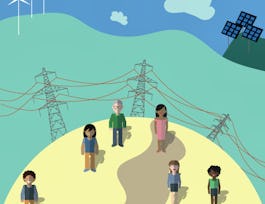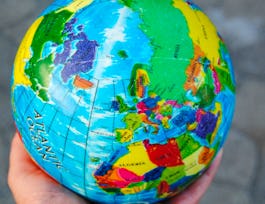This course is an introduction to ecology and ecosystem dynamics using a systems thinking lens. Through a case study on Mozambique's Gorongosa National Park, learners will explore how scientists study ecosystems, and investigate the complex array of factors that inform management efforts. At the end of the course, learners will be able to grapple with real-world conservation questions, such as whether an ecosystem can recover from anthropogenic disruption and what role humans can, and should, play in that recovery.



Ecology: Ecosystem Dynamics and Conservation

Instructor: Ana Luz Porzecanski
Sponsored by Mojatu Foundation
70,104 already enrolled
(3,270 reviews)
Details to know

Add to your LinkedIn profile
5 assignments
See how employees at top companies are mastering in-demand skills


Earn a career certificate
Add this credential to your LinkedIn profile, resume, or CV
Share it on social media and in your performance review

There are 5 modules in this course
We begin in Gorongosa National Park, Mozambique, and pose the question: Can this ecosystem recover after a 15-year civil war? To answer this question, learners must first consider what they need to know—what are the parts that make up this ecosystem, and how do they interact and work together? How do ecosystems react to disruption? How do we know? We will begin to explore the ecosystem as a dynamic whole rather than as a collection of parts, considering how changes might affect the system in a variety of ways. This application of a systems thinking lens to understanding ecosystems will be a common theme throughout the course.
What's included
3 videos7 readings1 assignment
This week, we narrow the focus to populations within ecosystems. Who or what populates an ecosystem, and what are their roles? How do these roles change over time? What happens when a species is removed from a system? How do scientists study the populations within an ecosystem, from its largest to its smallest inhabitants? You will explore the important roles different species can play—such as ecosystem engineers, keystone species, and indicator species—and how they shape their ecosystems.
What's included
3 videos2 readings1 assignment
This week we focus on community ecology and further explore the interactions between species in an ecosystem. For instance, how does the decline in a population from an ecosystem (as was the case in Gorongosa) affect the other players? How does adding a population -- such as an invasive species or translocated herds -- affect an ecosystem?
What's included
4 videos2 readings1 assignment
This week, we will further their understanding about what makes an ecosystem a system by examining the flow of energy and matter through different parts of the environment. This includes understanding the interactions of biotic and abiotic factors within an ecosystem and the services each component provides. We will introduce the complicated effects of both abiotic (climate change) and biotic (herbivory) interactions within a coastal salt marsh system, touching on ecological concepts of thresholds in a system and ecosystem resistance and resilience.
What's included
3 videos2 readings1 assignment
This week we conclude by focusing on the role of humans in ecosystems: how humans interact with and are shaped by their environments. We explore the meaning of the “anthropocene” (the title given to the current geological age in recognition of significant impact of human activities) and investigate management approaches that balance human needs and biodiversity. We also return to Gorongosa National Park to wrap up the course, shifting the conversation from "Can an ecosystem recover?" to "Should it recover?" and "What does a successful recovery look like?" We explore how conservation might have to adjust to future challenges such as climate change, extinctions, and human population growth. We also introduce the idea that a spectrum of conservation approaches is necessary, from the preservation of land and species, to the integration of biodiversity into market economies, to the creation and management of “novel” ecosystems.
What's included
4 videos3 readings1 assignment
Instructor

Why people choose Coursera for their career




Learner reviews
3,270 reviews
- 5 stars
86.27%
- 4 stars
12.28%
- 3 stars
1%
- 2 stars
0.15%
- 1 star
0.27%
Showing 3 of 3270
Reviewed on Jul 16, 2020
Super informative, great design and inspiring lecturers, this course was really an eye-opener for me. Highly recommended to all people interested in ecology. And also for those who aren't (yet) ;-)
Reviewed on May 17, 2021
Makes your perspective go on a larger scale due to the intertwined effects of humans to our natural habitat and what we can do to actually live with all organisms on Earth harmoniously.
Reviewed on Jan 3, 2021
One of the best course, I have ever taken. The materials is not hard to follow and the in-depth explanation gives you a proper new perspective which is still open to debate due to conservation topic
Recommended if you're interested in Health

University of Cape Town

Technical University of Denmark (DTU)

University of Michigan

Banco Interamericano de Desarrollo

Open new doors with Coursera Plus
Unlimited access to 10,000+ world-class courses, hands-on projects, and job-ready certificate programs - all included in your subscription
Advance your career with an online degree
Earn a degree from world-class universities - 100% online
Join over 3,400 global companies that choose Coursera for Business
Upskill your employees to excel in the digital economy




